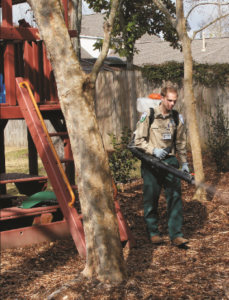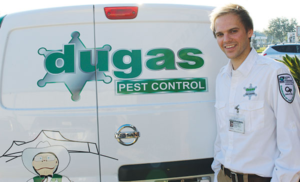The Internet is a treasure trove of stories and warnings about what you may or may not be bringing into your home with your purchases. One of these that has grown popular is the idea that you can begin a termite infestation in your home by purchasing bags of mulch. This myth is untrue on its face, but if you aren’t careful, you can contribute to an infestation through the manner in which you use mulch.
Why the Myth is Wrong
First things first; while it might be possible for a few termites to show up in bagged mulch, they are unlikely to cause an infestation. The reasons for this include:
- Survival – Only low numbers of termites can actually survive the chipping process that is used to create mulch.
- Colony Separation – In order for a colony to grow, there has to be a male and female together to mate. Even if both of these survived the chipping process, a colony requires between two and four years to fully mature.
- Low Survival Rates – Termites, including males and females who mate, have a low rate of survival when they are separated from the colony.
Based on this, the likelihood of your bags of mulch creating a termite infestation is very slim, and nearly impossible. However, it is true that your mulch could help promote an infestation if you don’t take the necessary precautions needed to keep those hungry little creatures that are already present in your soil away from your home.
Mulch and Established Colonies
Termites love moist soil that has a moderate temperature. If you lay your mulch down in thicknesses greater than four to six inches, you are providing the perfect ground cover to keep termites healthy, happy and thriving. When you use the appropriate level of mulch, which is around two inches or less, you ensure that the soil can dry naturally. When soil is dry, it does not provide the ideal living space for termites.
Insecticide Barriers
Another issue that arises when mulch layers are too thick is that it negates any termiticides that you may have in place. Thick layers allow termites to crawl over the mulch, without coming in contact with, or being deterred by insecticides that are in your soil. You should make sure to avoid going over two inches thick to ensure effectiveness. Additionally, you should ensure that you are protecting your home with a pest control company that is both licensed and reputable. These protections should include treating the soil appropriately, using bait systems, and making sure that all wood is treated appropriately.
Eliminating Conducive Conditions
Mulch is useful for a number of reasons, but it has to be used in the best ways to ensure you aren’t creating conducive conditions around the foundation of your home. It is recommended that any mulch placed near the foundation is at least six inches away to allow room for inspection. This will allow owners and pest control specialists to be able to see if there are any termite mud tubes leading into the foundation of the structure.
It is also important to ensure that any irrigation systems are placed so that they are at least one foot away from the wall of the home or building. This will make sure that conditions are not created that propagate termite infestations, such as overly moist soil right next to your foundation.
While you won’t be introducing a termite infestation when you place mulch around your home, you do have to take care to ensure you are not creating conditions that can lead to one. Proper thickness of the layers, along with leaving plenty of space between the walls and mulch, and taking precautionary measures will protect your home. Call Dugas Pest Control today for a termite inspection to ensure your home remains termite free.

 We often think of winter as the biggest time of the year to worry about pests entering our homes. After all, as the weather gets colder, insects and other small animals will seek out the warmth of your house to get out of the harsh elements. However, pest infestations in the spring pose an equally large problem for your home as they do in winter.
We often think of winter as the biggest time of the year to worry about pests entering our homes. After all, as the weather gets colder, insects and other small animals will seek out the warmth of your house to get out of the harsh elements. However, pest infestations in the spring pose an equally large problem for your home as they do in winter. No matter what kind of business you run – whether you have a restaurant or retail store, or you manage an office or other business – you can benefit greatly from commercial pest control services.
No matter what kind of business you run – whether you have a restaurant or retail store, or you manage an office or other business – you can benefit greatly from commercial pest control services.  Few things cause the level of revulsion elicited by the bedbug. This small, blood-sucking creature is one that has not only invaded our homes, but they are now found in high-end hotels, offices, public transportation systems, and even in business offices. Anyone can fall prey to these hardy bugs, and it is important to know what you may be doing that can result in an infestation in your home.
Few things cause the level of revulsion elicited by the bedbug. This small, blood-sucking creature is one that has not only invaded our homes, but they are now found in high-end hotels, offices, public transportation systems, and even in business offices. Anyone can fall prey to these hardy bugs, and it is important to know what you may be doing that can result in an infestation in your home. If you live in Louisiana, you know that winter can be the biggest pest season of the year, if you’re not careful. While you aren’t as likely to get eaten alive by mosquitoes when you step out the front door, as the weather gets colder, ants, roaches, mice, snakes, and other pests seek out warm places to weather the winter.
If you live in Louisiana, you know that winter can be the biggest pest season of the year, if you’re not careful. While you aren’t as likely to get eaten alive by mosquitoes when you step out the front door, as the weather gets colder, ants, roaches, mice, snakes, and other pests seek out warm places to weather the winter. As the winner of the 2014 Crown Leadership Award, Laura Simpson exemplifies the ideals of thoughtful and strong leadership. And yet there is so much more to know about her than the simple fact that she is a leader recognized by her entire industry.
As the winner of the 2014 Crown Leadership Award, Laura Simpson exemplifies the ideals of thoughtful and strong leadership. And yet there is so much more to know about her than the simple fact that she is a leader recognized by her entire industry. Although the number of different diseases that can infect humans is quite large, most people are affected by only a few of them, and many of the diseases people do experience are easily overcome. The same seems to be true of wild animals, although statistical records do not always tell us which animals are most apt to experience what diseases and how serious some of those diseases can be. What is known is that some wild animal diseases can be passed on to humans, and several of them can be quite serious and potentially deadly.
Although the number of different diseases that can infect humans is quite large, most people are affected by only a few of them, and many of the diseases people do experience are easily overcome. The same seems to be true of wild animals, although statistical records do not always tell us which animals are most apt to experience what diseases and how serious some of those diseases can be. What is known is that some wild animal diseases can be passed on to humans, and several of them can be quite serious and potentially deadly. If you have an attic in your house which you use for storage and frequently visit, the chances of one or more squirrels taking up residence there, particularly during the winter, are quite low. If the attic is empty or rarely visited however, the story can be quite different.
If you have an attic in your house which you use for storage and frequently visit, the chances of one or more squirrels taking up residence there, particularly during the winter, are quite low. If the attic is empty or rarely visited however, the story can be quite different.